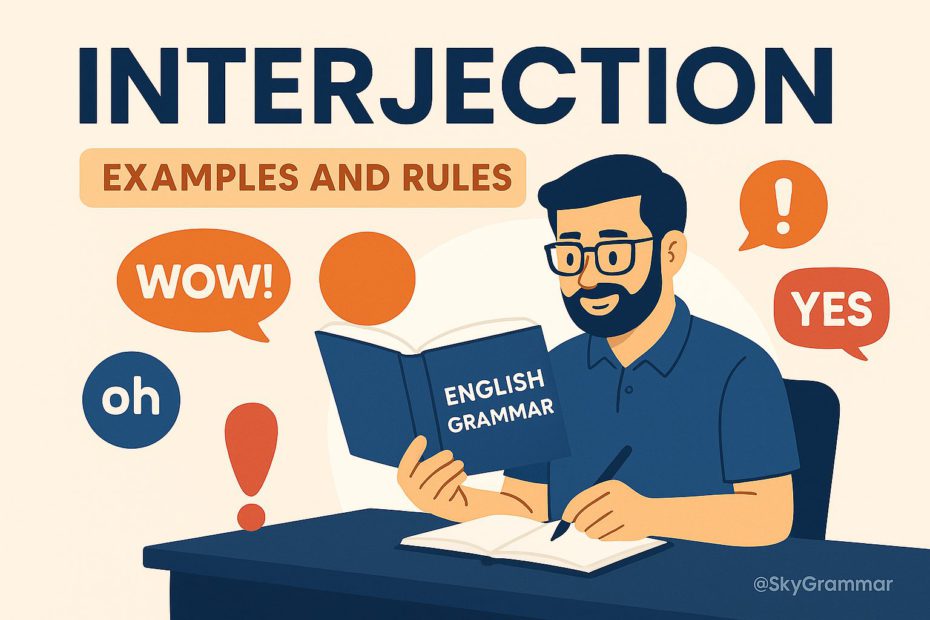Language isn’t just about structure and formality—sometimes, it’s about emotion, surprise, or spontaneous reaction. That’s where interjections come in. These small but powerful words or phrases help express feelings, reactions, or sudden thoughts, and they add life to everyday communication.
In this guide, we’ll explore what interjections are, how they’re used, and why they’re an important part of English grammar.
📘 What Is an Interjection?
An interjection is a word or short phrase used to express a strong emotion or sudden reaction. Unlike other parts of speech, interjections don’t grammatically relate to the rest of the sentence—they stand alone or are set apart by punctuation.
✨ Key Characteristics of Interjections:
- They express emotion, reaction, or feeling.
- They are often followed by an exclamation mark (!) or a comma (,).
- They may appear independently or be included within a sentence.
- They function separately from the grammatical structure of the sentence.
📣 Common Interjections (with Examples)
Here are some frequently used interjections, categorized by the emotion or reaction they express:
1. Surprise or Shock
- Wow! That sunset is incredible.
- Oh! I didn’t see you standing there.
- Gosh! That was a close call.
2. Joy or Excitement
- Yay! We finally won the game.
- Hooray! It’s summer vacation!
- Yippee! I got an A on my test!
3. Disappointment or Sadness
- Oh no! I missed the bus.
- Alas! The hero could not save the village.
- Aww! That adorable puppy looks a bit sad.
4. Pain or Suffering
- Ouch! That needle hurt!
- Ow! You stepped on my foot!
- Ugh! I have a headache.
5. Anger or Frustration
- Darn! I forgot my homework again.
- Hey! Watch where you’re going!
- Shoot! I dropped my phone.
6. Greeting or Parting
- Hello! How are you today?
- Hi! It’s nice to meet you.
- Goodbye! See you tomorrow.
7. Thinking or Hesitation
- Hmm… I’m not sure about that answer.
- Well… Maybe you’re right.
- Uh-oh! Something’s not right.
✍️ How to Use Interjections in Sentences
Interjections are flexible. They can appear at the beginning, middle, or end of a sentence, depending on the tone and style of speech or writing.
✅ Beginning of a sentence:
- Oh no, we forgot to lock the door!
- Wow, that’s amazing!
✅ In the middle:
- I was walking down the street when, bam!, a car backfired.
✅ At the end:
- You’re getting a new bike, yay!
Interjections are often separated by commas (for mild expressions) or exclamation marks (for strong emotion).
🎯 Formal vs. Informal Usage
Interjections are more commonly used in informal settings—such as conversations, social media, or creative writing—because they mirror natural human speech. In formal writing (like essays or academic reports), they’re generally avoided.
❌ Formal:
The results indicate a significant correlation between factors.
(Not recommended: “Whoa! The results were shocking.”)
✅ Informal:
Whoa! That experiment really worked!
🧱 Types of Interjections
While most interjections express feelings, they can be grouped based on function and tone:
1. Primary Interjections
Stand-alone words that don’t belong to any other part of speech.
- Examples: wow, ouch, oh, yay, ugh
2. Secondary Interjections
Words originally from other parts of speech but used to express emotion.
- Examples: well, indeed, sure, hey, now
✏️ Punctuation Rules for Interjections
Punctuation matters when using interjections:
- Use an exclamation mark (!) for strong emotion:
→ Yikes! That spider is huge! - Use a comma for softer expressions:
→ Well, I suppose you’re right. - Use parentheses or dashes to insert interjections within sentences:
→ He was—ouch!—bitten by a mosquito.
❗ Interjections vs. Other Parts of Speech
Avoid mistaking interjections for verbs or adverbs that express emotion. True interjections stand alone and are not grammatically linked to the sentence—they neither modify nor describe any part of it.
Compare:
- Interjection:
→ Oops! I dropped the plate. - Adverb:
→ He responded calmly to the situation.
🧠 Final Tips for Mastering Interjections
- Use sparingly in formal writing: They are best reserved for storytelling, dialogue, or casual content.
- Match tone and punctuation: Choose a comma or exclamation mark depending on intensity.
- Be mindful of audience: Not all interjections are universal—some are culture- or language-specific.
🎓 Conclusion
Interjections may be the smallest part of speech, but they pack a punch. Whether you’re surprised, excited, confused, or in pain, interjections help express it quickly and clearly. By understanding how to use them, you’ll add emotion and authenticity to your writing and speech.
Next time you say “Wow!” or “Oops!”—you’ll know exactly what part of speech you’re using!

